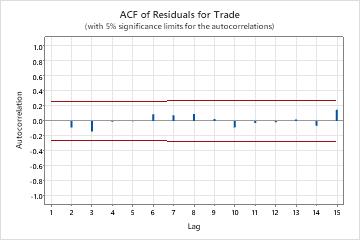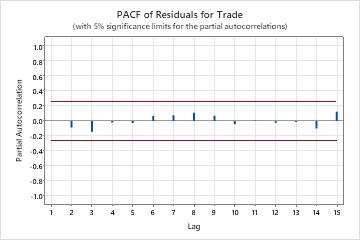In This Topic
Step 1: Consider alternative models
The Model Selection table displays the criteria for each model in the search. The table displays the order of the terms where p is the autoregressive term, d is the differencing term, and q is the moving average term. Seasonal terms use upper-case letters and non-seasonal terms use lower-case letters.
Use AIC, AICc and BIC to compare different models. Smaller values are desirable. However, the model with the least value for a set of terms does not necessarily fit the data well. Use tests and plots to assess how well the model fits the data. By default, the ARIMA results are for the model with the best value of AICc.
Select Select Alternative Model to open a dialog that includes a the Model Selection table. Compare the criteria to investigate models with similar performance.
Use the ARIMA output to verify that the terms in the model are statistically significant and that the model meets the assumptions of the analysis. If none of the models in the table fit the data well, consider models with different orders of differencing.
- Coefficients can seem to be insignificant even when a significant relationship exists between the predictor and the response.
- Coefficients for highly correlated predictors will vary widely from sample to sample.
- Removing any highly correlated terms from the model will greatly affect the estimated coefficients of the other highly correlated terms. Coefficients of the highly correlated terms can even have the wrong sign.
Model Selection
| Model (d = 1) | LogLikelihood | AICc | AIC | BIC |
|---|---|---|---|---|
| p = 0, q = 2* | -197.052 | 400.878 | 400.103 | 404.769 |
| p = 1, q = 2 | -196.989 | 403.311 | 401.978 | 408.199 |
| p = 1, q = 0 | -201.327 | 407.029 | 406.654 | 409.765 |
| p = 2, q = 0 | -200.239 | 407.251 | 406.477 | 411.143 |
| p = 1, q = 1 | -200.440 | 407.655 | 406.880 | 411.546 |
| p = 2, q = 1 | -201.776 | 412.884 | 411.551 | 417.773 |
| p = 0, q = 1 | -204.584 | 413.542 | 413.167 | 416.278 |
| p = 0, q = 0 | -213.614 | 429.350 | 429.229 | 430.784 |
Key results: AICc, BIC, and AIC
The ARIMA(0, 1, 2) has the best value of AICc. The ARIMA results that follow are for the ARIMA(0, 1, 2) model. If the model does not fit the data well enough, consider other models with similar performance, such as the ARIMA(1, 1, 2) model and the ARIMA (1, 1, 1) model. If none of the models fit the data well enough, consider whether to use a different type of model.
Step 2: Determine whether each term in the model is significant
- P-value ≤ α: The term is statistically significant
- If the p-value is less than or equal to the significance level, you can conclude that the coefficient is statistically significant.
- P-value > α: The term is not statistically significant
- If the p-value is greater than the significance level, you cannot conclude that the coefficient is statistically significant. You may want to refit the model without the term.
Final Estimates of Parameters
| Type | Coef | SE Coef | T-Value | P-Value |
|---|---|---|---|---|
| AR 1 | -0.504 | 0.114 | -4.42 | 0.000 |
| Constant | 150.415 | 0.325 | 463.34 | 0.000 |
| Mean | 100.000 | 0.216 |
Key Results: P, Coef
The autoregressive term has a p-value that is less than the significance level of 0.05. You can conclude that the coefficient for the autoregressive term is statistically significant, and you should keep the term in the model.
Step 3: Determine whether your model meets the assumptions of the analysis
- Ljung-Box chi-square statistics
- To determine whether the residuals are independent, compare the p-value to the significance level for each chi square statistic. Usually, a significance level (denoted as α or alpha) of 0.05 works well. If the p-value is greater than the significance level, you can conclude that the residuals are independent and that the model meets the assumption.
- Autocorrelation function of the residuals
- If no significant correlations are present, you can conclude that the residuals are independent. However, you may see 1 or 2 significant correlations at higher order lags that are not seasonal lags. These correlations are usually caused by random error instead and are not a sign that the assumption is not met. In this case, you can conclude that the residuals are independent.
- Partial autocorrelation function of the residuals
- If no significant correlations are present, you can conclude that the residuals are independent. However, you may see 1 or 2 significant correlations at higher order lags that are not seasonal lags. These correlations are usually caused by random error instead and are not a sign that the assumption is not met. In this case, you can conclude that the residuals are independent.
Modified Box-Pierce (Ljung-Box) Chi-Square Statistic
| Lag | 12 | 24 | 36 | 48 |
|---|---|---|---|---|
| Chi-Square | 4.05 | 12.13 | 25.62 | 32.09 |
| DF | 10 | 22 | 34 | 46 |
| P-Value | 0.945 | 0.955 | 0.849 | 0.940 |


Key Results: P-Value, ACF of Residuals, PACF of residuals
In these results, the p-values for the Ljung-Box chi-square statistics are all greater than 0.05. None of the correlations for the autocorrelation function of the residuals or the partial autocorrelation function of the residuals are significant. You can conclude that the model meets the assumption that the residuals are independent.
